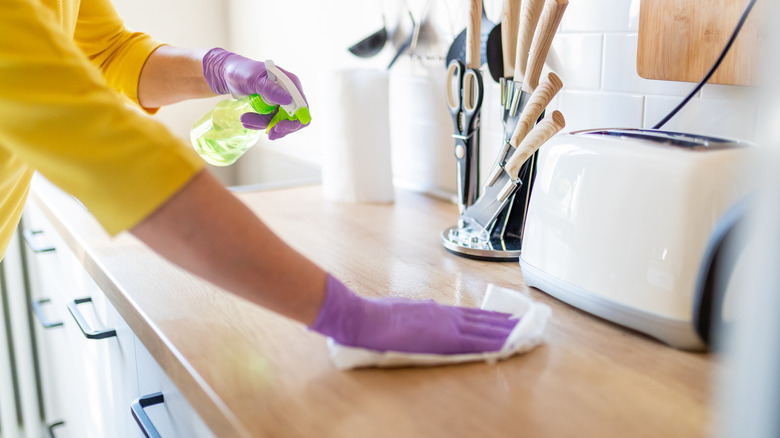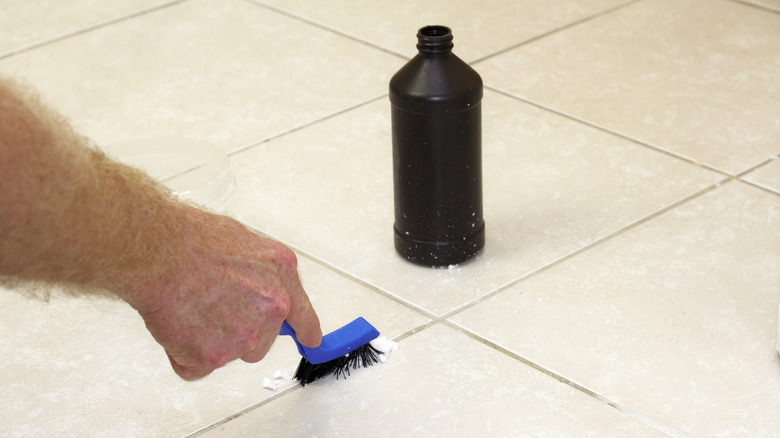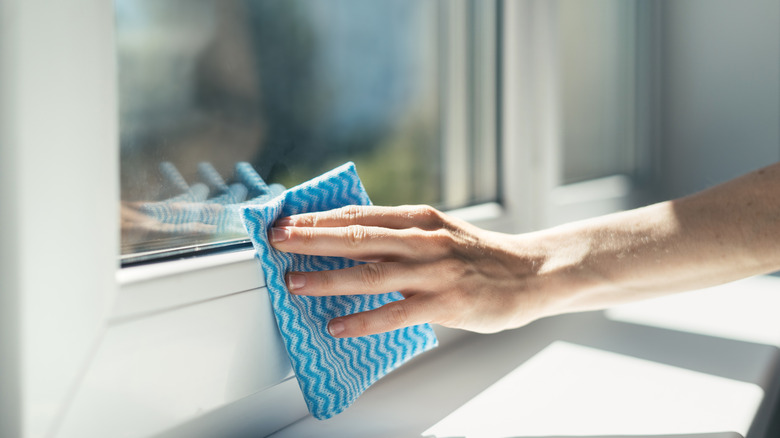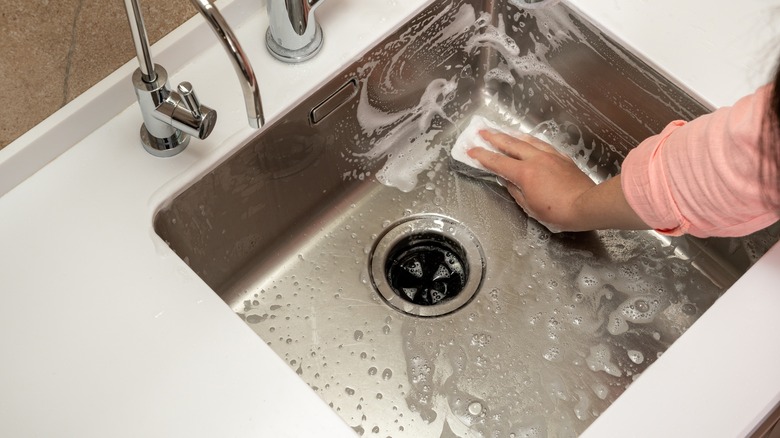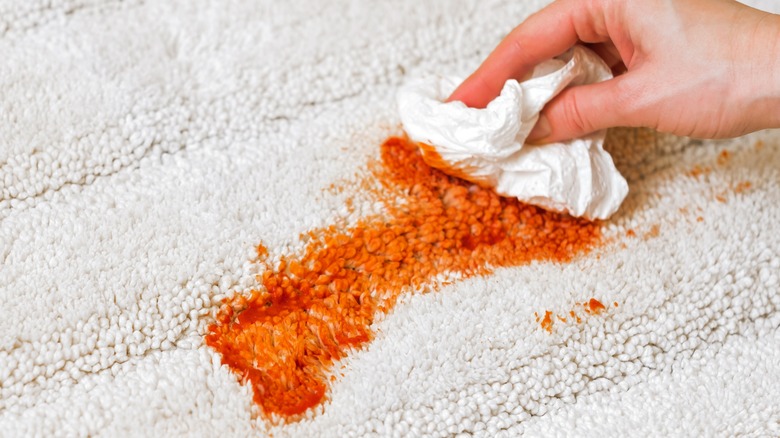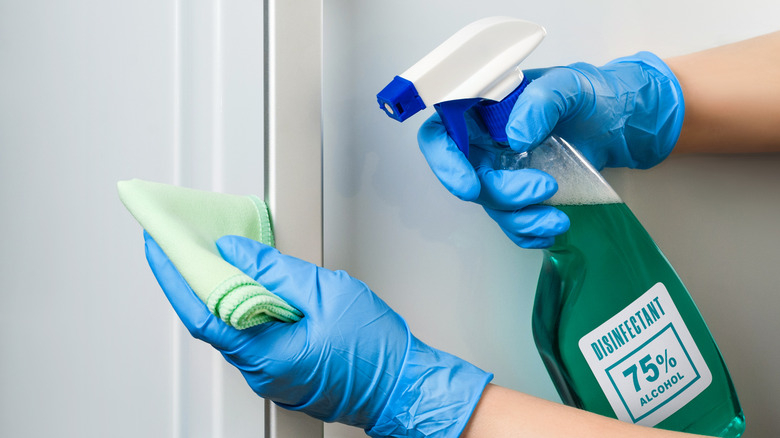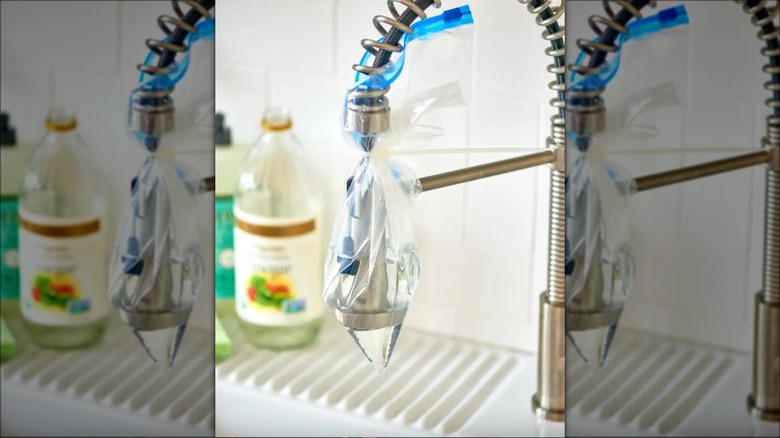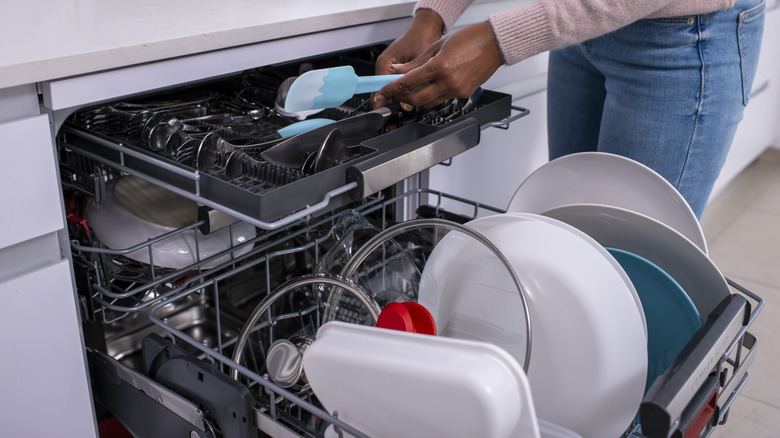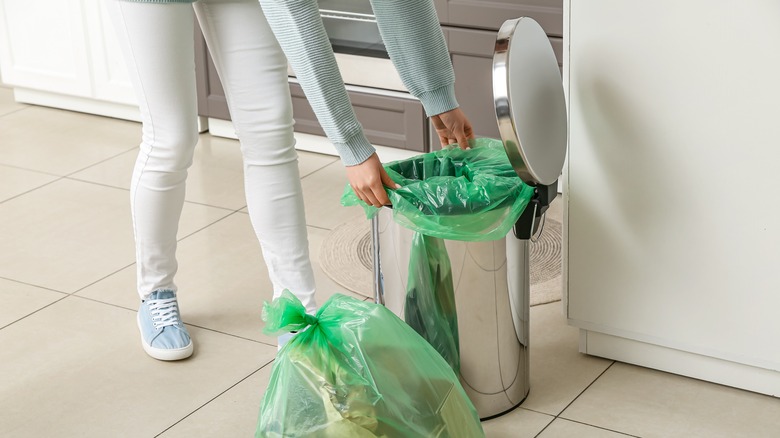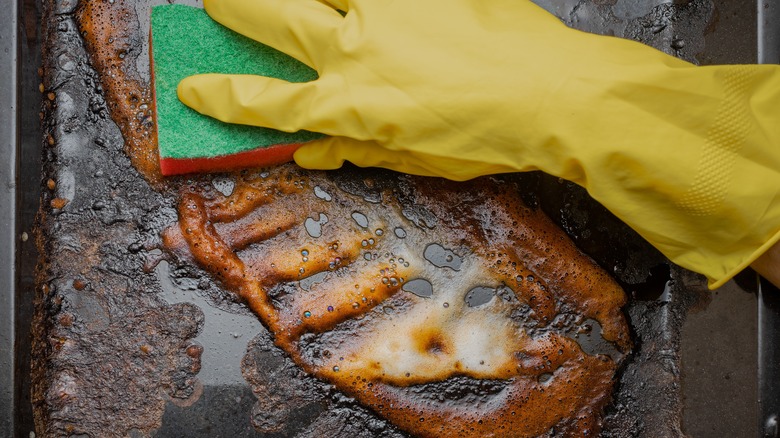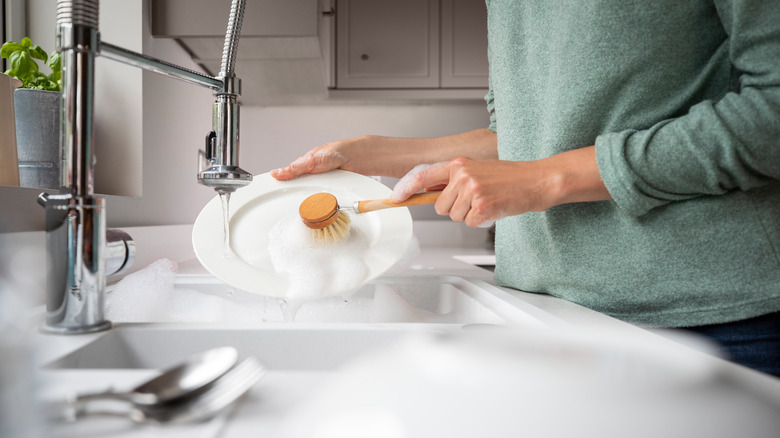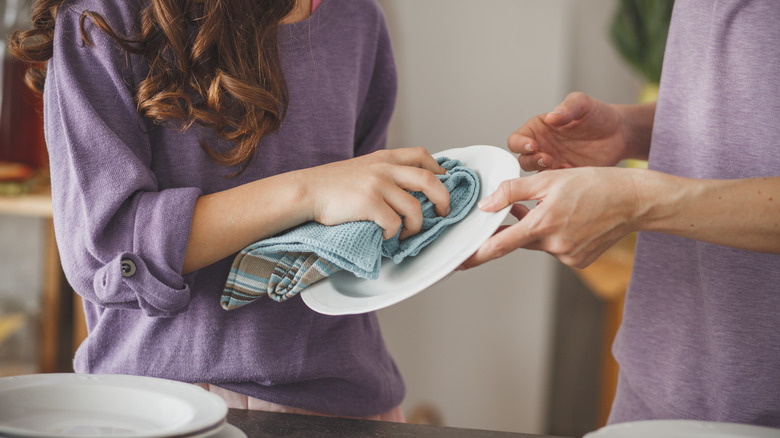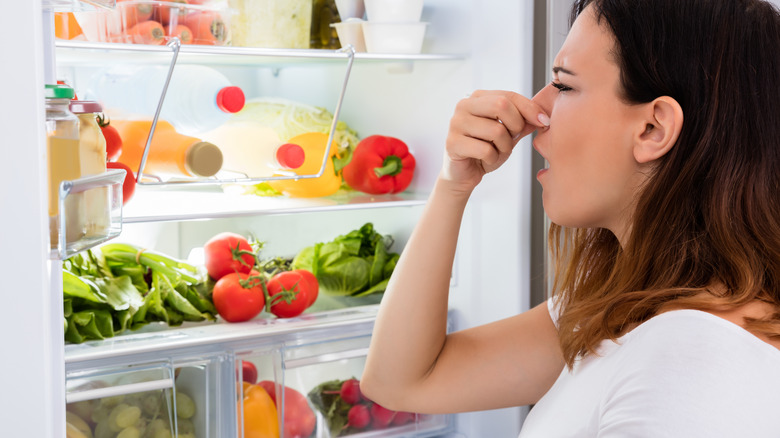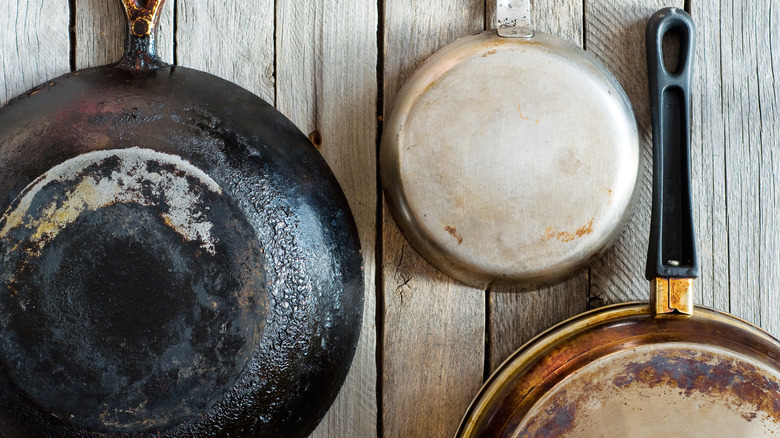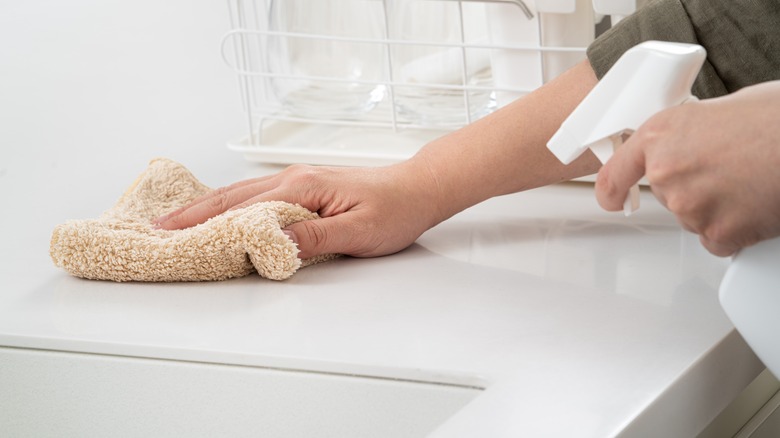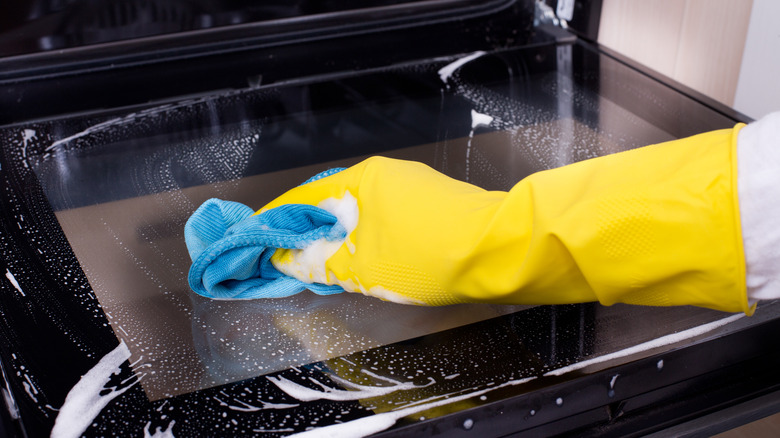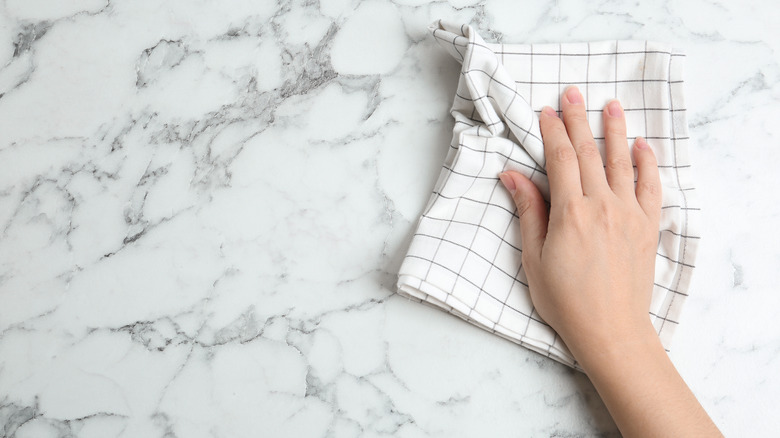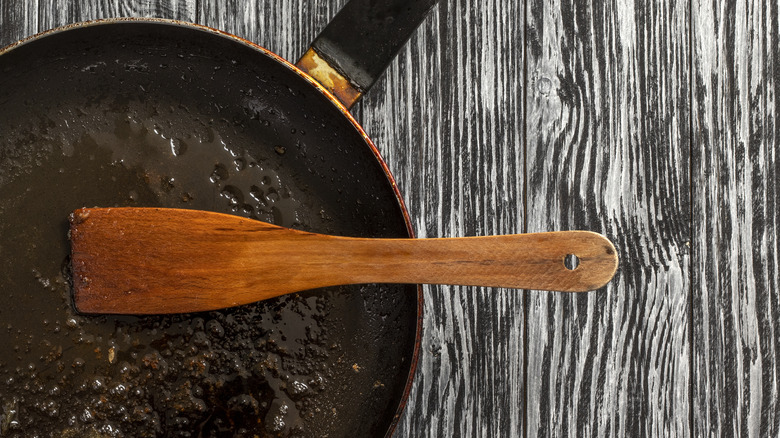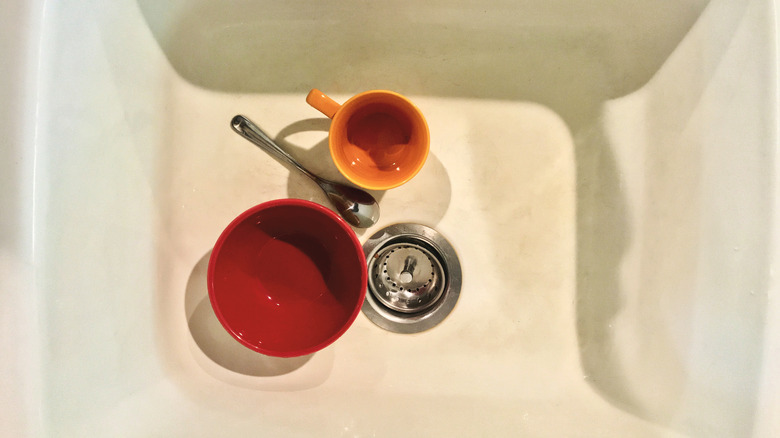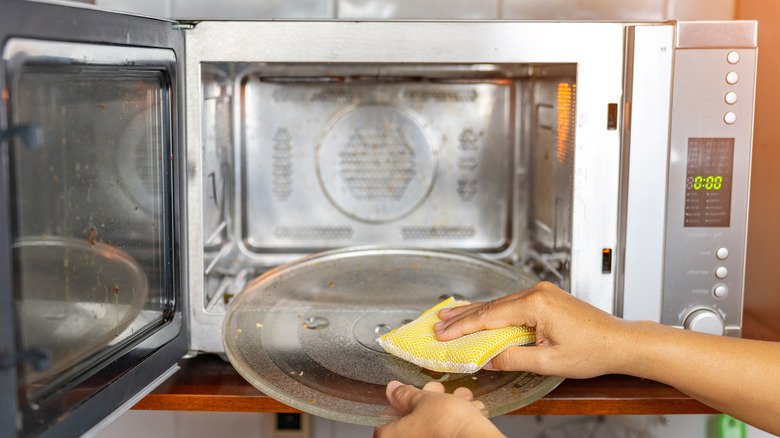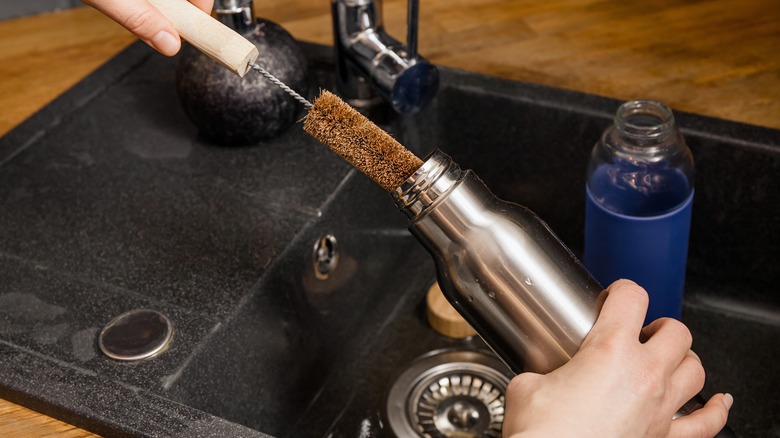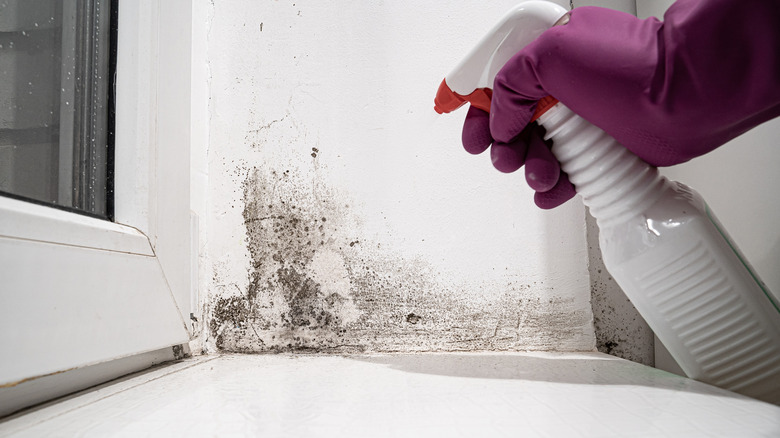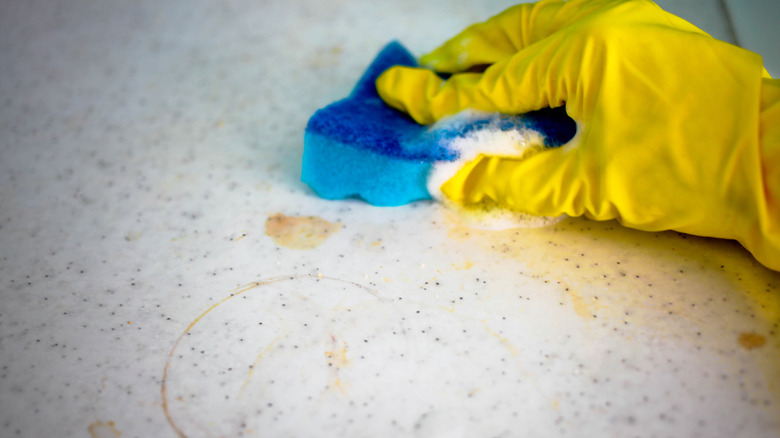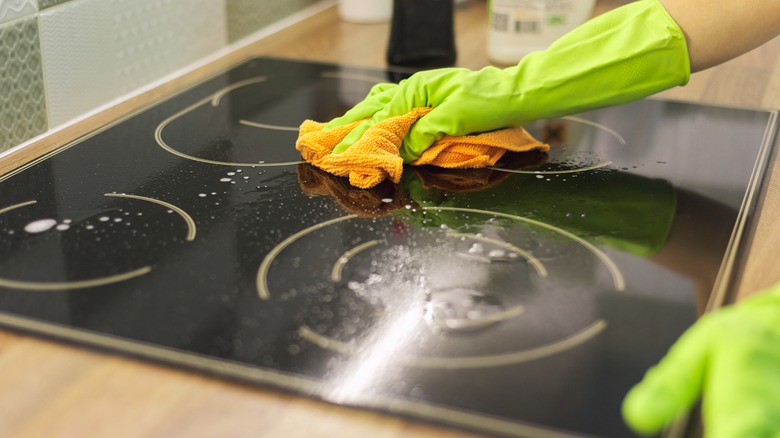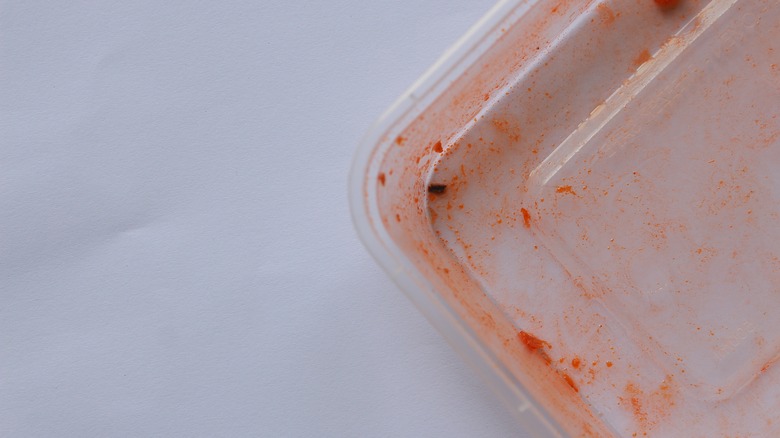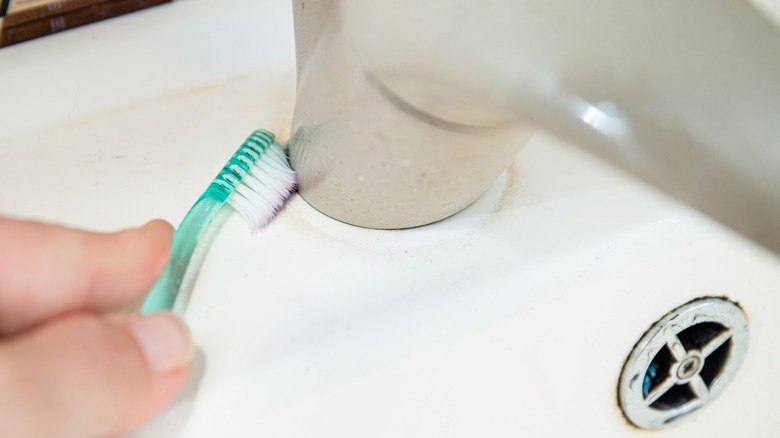Genius Hydrogen Peroxide Hacks That'll Leave Your Kitchen Dazzling Clean
Hydrogen peroxide is most commonly known for its previous use in the treatment of minor scrapes and wounds. However, though it isn't recommended for this use anymore (per the Cleveland Clinic), like many other household essentials, hydrogen peroxide has plenty of other surprising uses around the home. For instance, it's a common inclusion in natural cleaning solutions that promise similar results to store-bought cleaners. This is because it acts as a disinfectant that can kill bacteria, fungi, and viruses on surfaces. Additionally, hydrogen peroxide can do some serious heavy lifting as a stain remover, meaning it can help out on some of your soft surfaces, too.
Nowadays, there are plenty of different options for more natural cleaning solutions available to purchase from the store, but when it comes to spaces where your family will be preparing and eating food, it makes sense to want to stick with cleaners you can guarantee are free from harsh or harmful chemicals. By trying out some of these 26 hacks in your own kitchen, you'll be able to rest assured that your surfaces stay sparkling clean without having to worry about exactly what's mixed into your disinfectant spray or all-purpose cleaner. You might even find that you're able to save a bit of extra money, too. However, if you try out these hacks, choose 3% hydrogen peroxide, ensure you wear gloves and ventilate the area, and never mix hydrogen peroxide with vinegar.
1. Lighten grout lines
Grout lines, especially if they're a lighter color, can trap and show dirt and grime even more than the surrounding tile. Because of this, it's important to routinely scrub these connection points to ensure they stay spotless and remain free from stains. To easily lift dirt, slightly wet the grout with hydrogen peroxide, then sprinkle a bit of baking soda over the top. After scrubbing with a toothbrush, rinse to reveal a sparkling clean surface. This method obviously works on tiled floors, but it can also help to bring back the sparkle on backsplashes or tiled countertops in your kitchen.
2. Wipe down windows
Wiping down your windows to ensure they're clear and streak-free is an essential step in any cleaning routine, but using water or non-specific cleaning sprays can leave you with annoying spots and residue once everything dries. Luckily, however, you don't have to look far for a solution. As it turns out, hydrogen peroxide can make a great substitute for glass cleaner and will leave your windows sparkling clean, even if they're the frequent victims of splashes and smudges thanks to their position in such a high-traffic room. Simply dilute some hydrogen peroxide with water, then spray it on your windows and wipe clean.
3. Disinfect the sink
Your kitchen sink might be the place where you clean your dishes, but the sink itself needs to get a good cleaning every now and then, too. A simple scrub with some dish soap when you're done washing dishes can help to remove any debris, but it's also important to ensure it's properly disinfected to prevent the spread of germs. To do this, simply swap water and dish soap for diluted hydrogen peroxide (and baking soda, if desired) the next time you give your sink a wipe down. You can also pour some hydrogen peroxide down the drain to help eliminate unpleasant smells.
4. Remove stains from rugs
Most kitchens have either hardwood or tiled floors that are easy to clean, but it's common to add a rug or two in spots where you frequently stand to make cooking and cleaning more comfortable. Unfortunately, these rugs are directly in the line of fire for spills and dropped food. Next time you face a spill, dab up the excess, then spray on some hydrogen peroxide to help lift the stain. After scrubbing, it should be as good as new. However, it is important that you test this out on an inconspicuous part of the rug first, as hydrogen peroxide can bleach fabrics.
5. Disinfect handles
In the kitchen, there are plenty of different high-touch surfaces that should be routinely disinfected to ensure germs don't spread. The most common of these, of course, are handles. Both handles on cabinets and drawers and those on appliances like the refrigerator and oven get a ton of use each day, so frequent wipe downs with hydrogen peroxide can be beneficial, especially if someone in the home appears to be sick. All you need to do is spray down your surfaces, allow the hydrogen peroxide to sit for a few seconds, then wipe it away with a rag or a paper towel to finish the job.
6. Remove mineral buildup on faucets
Over time, your faucets may start to develop some limescale buildup — one of the horrors of having hard water in your home. Removing this buildup is important, especially if it begins to clog the flow of water, but it can be difficult to completely eradicate. Instead of scraping it out by hand, try soaking your faucet in diluted hydrogen peroxide. Fill a plastic bag with the mix, put it over your faucet, and tie it off to secure it. Let it soak for a half hour or so, then remove it and give the faucet head a good scrub.
7. Eliminate unpleasant dishwasher smells
Despite the fact that they're constantly going through cleaning cycles, dishwashers can get a bit smelly over time, especially if you load your dishes when they still have a bit of food residue on them. To use hydrogen peroxide to clean your dishwasher, fill a small cup or ramekin with this product and place it on the top rack before you run your next dish cycle. This way, the dishwasher will do the work for you, essentially mixing the hydrogen peroxide into the water it uses for cleaning, helping to spread it around the inside of the appliance.
8. Sanitize trash cans
Even when you use a sturdy trash bag, there are still moments when food scraps, debris, and liquid can end up inside or on the outside of your kitchen trash can. Because of this, it's necessary to clean the trash can itself to help prevent smells and decrease the chances of bacteria forming. Thankfully, this doesn't take all that much work if you're using the proper tools. After you take your trash out, spray down the inside and outside of your empty can with hydrogen peroxide. Wipe it down to clean away any residue, then allow it to dry either inside or out in the sun.
9. Kill germs on cutting boards
Despite the fact that they're designed to give you a surface on which to cut meat, vegetables, and fruit, cutting boards need a bit of extra treatment beyond regular washing to ensure they stay safe to use over time. Certain materials, like wood and plastic, tend to absorb some of the liquid that's released by whatever you're cutting. While this is just a nuisance for things like fruit and vegetables, it can present a serious health issue when you're handling meats. Therefore, to prevent the spread of bacteria, consider soaking your cutting board in hydrogen peroxide, then rinsing it thoroughly with hot water.
10. Clear away stuck-on grease
Grease is notoriously one of the most stubborn things to clean, and the kitchen is full of it. After grease spots have been exposed to heat, they require a bit of special treatment beyond a basic all-purpose cleaner. Luckily, hydrogen peroxide and baking soda can create the perfect mix for tackling these annoying spots of stuck-on reside. Mix hydrogen peroxide with baking soda to create a paste, apply it to the spots in question, and allow it to sit overnight. When you go to wipe away the reside, the grease should lift much more easily and require less scrubbing to clear away.
11. Sanitize sponges and dish brushes
Sponges and dish brushes might help us clean our dishes, but after constant exposure to water, food scraps, and debris, it's likely that they need a bit of a clean as well. If you feel that your cleaning tools are looking a bit dingy or are worried about their potential for spreading germs onto your plates, consider giving them a soak. Pour some hydrogen peroxide into a cup or ramekin and soak your sponge or brush in the liquid for a few minutes. Rinse them off with some hot water, and they should emerge ready to clean.
12. Deodorize smelly towels
Having a few dish towels around the kitchen is essential for cleaning up small messes, drying your hands, and wiping down plates, but constant use and imperfect storage can mean that these towels are prone to picking up unpleasant odors. Whether you're dealing with mildew after leaving a wet towel crumbled up on the counter or a stuck-on smell after cooking with particularly-flavorful ingredients, a soak in a mix of water and hydrogen peroxide can help. Fill a tub with warm water, add about ½ a cup of hydrogen peroxide, then soak your towels for about 30 minutes. After washing, they should smell as good as new.
13. Freshen up the fridge
Even when it looks clean, it's not uncommon to notice that your fridge is harboring a bit of an unpleasant smell. Past its prime produce, drips from meat, and expired perishables can combine to create an odor that's difficult to get rid of, even after removing the source. To help eliminate the stink, consider deep cleaning your fridge with a hydrogen peroxide-soaked rag or paper towel. It will help to clear away any remaining residue on your shelves and drawers while also sanitizing them, meaning that you'll get a deep clean without having to rely on harsher chemicals that you wouldn't want near your food.
14. Restore crusty pans
Over time, pans can end up developing layers of buildup and burnt spots that can detract from both their look and functionality. If you notice it's time for a deep clean on your cookware, there's no reason to shell out money on a specially-made cleaner. Instead, the solution is likely already in your cabinets: hydrogen peroxide and baking soda. Sprinkle baking soda over the dirty spots on your pan, then cover them with hydrogen peroxide until you get a paste-like consistency. Leave this mixture on the pan for an hour or two, then scrub it away to reveal a spotless surface.
15. Make all-purpose cleaner
If you're just looking to do a routine wipe down but you're running low on your go-to all-purpose cleaner, consider making your own. All you need is 1 cup of hydrogen peroxide, 2 cups of water, and a couple tablespoons of lemon juice. Add this mix to an opaque spray bottle, then get to work spritzing. If you're not a fan of the smell of the cleaner and want something a bit more fresh, you can also add a few drops of your favorite essential oil to fragrance the mix. This will leave behind a pleasant smell, even after the spray is wiped away.
16. Clean the oven door
Ovens are notorious for being one of the most difficult things to clean around the kitchen. As a result, it's not uncommon to break out ultra heavy-duty cleaners that promise to cut through whatever residue you're facing, often with the unfortunate tradeoff of dangerous fumes and powerful chemicals. While these cleaners are certainly efficient, there's an alternative that can get you the same squeaky-clean finish without worry: baking soda and hydrogen peroxide. Mix these two ingredients into a paste, allow it to sit for a few hours, and scrub it away to help cut through all of those caked-on grease stains.
17. Brighten dingy towels
Over time and with frequent use, just about anything will wear out. Towels are no exception to this rule, and the dish rags found in the kitchen are some of the most used towels in the house. To help restore them to their former vibrancy, whether you're looking to bring back faded color or revive dull whites, consider using hydrogen peroxide. Add a cup to your washer's bleach dispenser during your next cycle to ensure it's evenly dispersed. Before doing this, however, it is important to test if your dyed items are colorfast, as hydrogen peroxide could lift dye on items already prone to leeching.
18. Remove stains from cooking utensils
After repeated use, especially if you find yourself cooking with more vibrant ingredients like tomatoes, turmeric, and peppers, cooking utensils can end up with unsightly stains that refuse to wipe away even after a solid amount of scrubbing. This is incredibly common on wooden utensils, but it can also occur on lighter-colored plastic and silicone spatulas, too. To get rid of these spots and restore your cooking utensils to their original color, soak them in a solution of hydrogen peroxide and water for a few minutes, then wash them as normal. You should notice that the staining has either reduced or lifted entirely.
19. Brighten stained ceramic
While ceramic might be more durable than expected, it's also prone to staining with use. Most kitchen sinks nowadays are made of stainless steel to help avoid this issue, but it's still common to find older sinks made of light-colored ceramic. If you have one such model and it's looking like it has seen better days, try using some hydrogen peroxide to brighten the surface and to help bleach out any stains. Sprinkle some baking soda over the worst stained spots, then spray hydrogen peroxide over the top until you're left with a workable paste. After a quick scrub, the basin should look noticeably brighter.
20. Cut through microwave splatters
While it's easier to ignore messes in the microwave because they're hidden from view most of the time, these appliances can quickly become one of the dirtiest spots in the kitchen. Food splatters, spills, and splashes can build up over just about every surface inside, and they only become more difficult to wipe away with time. Luckily, hydrogen peroxide has the power to cut through debris on metal, plastic, and glass without causing damage. Using hydrogen peroxide as a cleaning agent is also particularly helpful when it comes to the microwave's display and window, as it's less likely to leave spots and streaks than other cleaners.
21. Disinfect reusable water bottles
Reusable water bottles are a great way to cut down on your plastic waste, but they can get a bit tricky to clean. It's important to get into each and every nook and cranny with a brush to ensure you eliminate any buildup or debris, but it's also a good idea to give the bottle an additional sanitizing wash to kill any lingering germs that could get you sick. Pour a small amount of hydrogen peroxide into your bottle, swish it around, and release some through the straw if applicable. Give it a thorough wash after, and you're good to go.
22. Remove mold and mildew
Mold is never a pleasant sight to see, but it's even more concerning when you find it in your kitchen, right next to where you prepare food. Unfortunately, the kitchen is also one of the most common places to find mold, especially in damp corners like those behind the fridge or under the sink. If you're dealing with large amounts of growth or dangerous black mold, call in a professional right away. However, smaller spots on hard surfaces can be cleaned up on your own with hydrogen peroxide. Thoroughly spray down the surface, then wipe the mold away with a paper towel after a few minutes.
23. Remove stains on the countertop
Even if you choose the most durable material for your countertops, it's likely that you'll face the occasional stain now and then. Luckily, our old friend hydrogen peroxide can come to the rescue. You know the drill: mix hydrogen peroxide and baking soda into a paste, apply to the stained area on your countertop, then scrub it off with soapy water after a few minutes. This method can even work on more damage-prone natural stone like marble, though it's always a good idea to test out your cleaner in an inconspicuous spot first in case the formula causes any accidental discoloration or bleaching.
24. Clean glass stovetops
Glass stovetops are one of the most aesthetically-pleasing and low-profile options out there, but they also have their fair share of issues. Namely, they have a tendency to pick up burn marks as soon as a pot boils over or you face a minor spill. Keeping the stovetop clear of debris is about as easy as any other surface, but these burn marks can be difficult to remove, especially without causing damage to the glass. If you don't want to invest in a specialized cleaner to get the job done, you can fall back on old reliable to achieve similar results: hydrogen peroxide and baking soda.
25. Clean stained storage containers
When you store certain foods in plastic containers, especially those that are tomato based or contain large amounts of spices, the containers tend to get stained and discolored. No matter how much scrubbing or how many dishwasher cycles the storage container goes through, they still look like they have a layer of food residue that refuses to budge. Sure, you can toss these containers or simply accept the stained look, but a soak in hydrogen peroxide can eliminate the problem once and for all. Allow the liquid to sit in the containers until you notice the stains lightening, then wash them as you normally would.
26. Scrub tight areas
The areas around the sink, corners of the countertop, and edges of the faucet are some of the most frequently-overlooked spots to clean, but they're also some of the most common places where dirt and grime can build up. If enough time has passed since the last cleaning, it's also not uncommon for previously light-colored caulk to stain. To both disinfect and lighten these spots, all you need is some baking soda, hydrogen peroxide, and an old toothbrush. Create a paste out of the baking soda and hydrogen peroxide, then apply it to the toothbrush like toothpaste and start scrubbing away for a deep clean.
